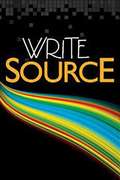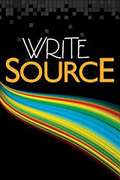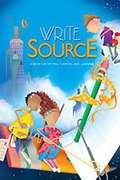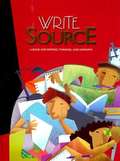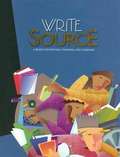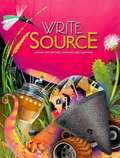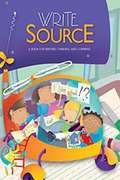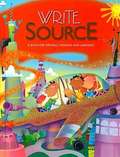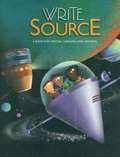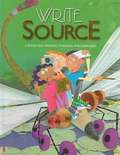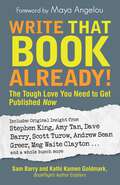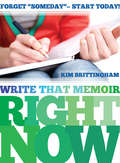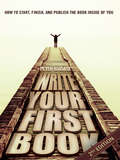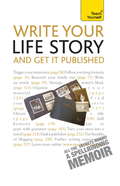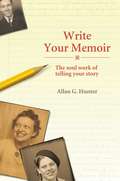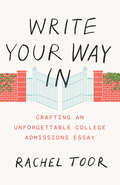- Table View
- List View
Write Source: A Book for Writing, Thinking, and Learning
by Dave Kemper Patrick Sebranek Verne Meyer Chris KrenzkeThis powerful classroom toolkit provides a variety of additional resources to help you make the most of the Write Source program: - SkillsBook Practice for essential mechanics, usage, and grammar skills (SkillsBook Teacher's Edition also included.)- Assessment Book Copymasters for a pretest, interim tests, and posttests to help prepare students for stare assessments- Overhead Transparencies Graphic organizers, assessment rubrics, and benchmark papers for whole-class instruction- Interactive Writing Skills CD-ROM Animated grammar lessons, engaging, interactive activities, and printable and e-mailable reports- Daily Language Workouts Quick 5-to-10 minute activities in mechanics, usage, grammar, and writing.
Write Source: A Book for Writing, Thinking, and Learning
by Dave Kemper Patrick Sebranek Verne Meyer Chris KrenzkeThis powerful classroom toolkit provides a variety of additional resources to help you make the most of the Write Source program: - SkillsBook Practice for essential mechanics, usage, and grammar skills (SkillsBook Teacher's Edition also included.)- Assessment Book Copymasters for a pretest, interim tests, and posttests to help prepare students for stare assessments- Overhead Transparencies Graphic organizers, assessment rubrics, and benchmark papers for whole-class instruction- Interactive Writing Skills CD-ROM Animated grammar lessons, engaging, interactive activities, and printable and e-mailable reports- Daily Language Workouts Quick 5-to-10 minute activities in mechanics, usage, grammar, and writing.
Write Source: A Book for Writing, Thinking, and Learning
by Dave Kemper Patrick Sebranek Verne Meyer Chris KrenzkeThis powerful classroom toolkit provides a variety of additional resources to help you make the most of the Write Source program: - SkillsBook Practice for essential mechanics, usage, and grammar skills (SkillsBook Teacher's Edition also included.)- Assessment Book Copymasters for a pretest, interim tests, and posttests to help prepare students for stare assessments- Overhead Transparencies Graphic organizers, assessment rubrics, and benchmark papers for whole-class instruction- Interactive Writing Skills CD-ROM Animated grammar lessons, engaging, interactive activities, and printable and e-mailable reports- Daily Language Workouts Quick 5-to-10 minute activities in mechanics, usage, grammar, and writing.
Write Source: A Book for Writing, Thinking, and Learning
by Dave Kemper Patrick Sebranek Verne Meyer Chris KrenzkeThis powerful classroom toolkit provides a variety of additional resources to help you make the most of the Write Source program: - SkillsBook Practice for essential mechanics, usage, and grammar skills (SkillsBook Teacher's Edition also included.)- Assessment Book Copymasters for a pretest, interim tests, and posttests to help prepare students for stare assessments- Overhead Transparencies Graphic organizers, assessment rubrics, and benchmark papers for whole-class instruction- Interactive Writing Skills CD-ROM Animated grammar lessons, engaging, interactive activities, and printable and e-mailable reports- Daily Language Workouts Quick 5-to-10 minute activities in mechanics, usage, grammar, and writing.
Write Source: A Book for Writing, Thinking, and Learning
by Dave Kemper Patrick Sebranek Verne Meyer Chris KrenzkeThis powerful classroom toolkit provides a variety of additional resources to help you make the most of the Write Source program: - SkillsBook Practice for essential mechanics, usage, and grammar skills (SkillsBook Teacher's Edition also included. )- Assessment Book Copymasters for a pretest, interim tests, and posttests to help prepare students for stare assessments- Overhead Transparencies Graphic organizers, assessment rubrics, and benchmark papers for whole-class instruction- Interactive Writing Skills CD-ROM Animated grammar lessons, engaging, interactive activities, and printable and e-mailable reports- Daily Language Workouts Quick 5-to-10 minute activities in mechanics, usage, grammar, and writing.
Write Source: A Book for Writing, Thinking, and Learning
by Dave Kemper Patrick Sebranek Verne Meyer Chris KrenzkeThis powerful classroom toolkit provides a variety of additional resources to help you make the most of the Write Source program: - SkillsBook Practice for essential mechanics, usage, and grammar skills (SkillsBook Teacher's Edition also included. )- Assessment Book Copymasters for a pretest, interim tests, and posttests to help prepare students for stare assessments- Overhead Transparencies Graphic organizers, assessment rubrics, and benchmark papers for whole-class instruction- Interactive Writing Skills CD-ROM Animated grammar lessons, engaging, interactive activities, and printable and e-mailable reports- Daily Language Workouts Quick 5-to-10 minute activities in mechanics, usage, grammar, and writing.
Write Source: A Book for Writing, Thinking, and Learning
by Dave Kemper Patrick Sebranek Verne Meyer Chris KrenzkeNIMAC-sourced textbook
Write Source: A Book for Writing, Thinking, and Learning
by Dave Kemper Patrick Sebranek Verne Meyer Chris KrenzkeThis powerful classroom toolkit provides a variety of additional resources to help you make the most of the Write Source program: - SkillsBook Practice for essential mechanics, usage, and grammar skills (SkillsBook Teacher's Edition also included. )- Assessment Book Copymasters for a pretest, interim tests, and posttests to help prepare students for stare assessments- Overhead Transparencies Graphic organizers, assessment rubrics, and benchmark papers for whole-class instruction- Interactive Writing Skills CD-ROM Animated grammar lessons, engaging, interactive activities, and printable and e-mailable reports- Daily Language Workouts Quick 5-to-10 minute activities in mechanics, usage, grammar, and writing.
Write Source: A Book for Writing, Thinking, and Learning
by Dave Kemper Patrick Sebranek Verne Meyer Chris KrenzkeThis powerful classroom toolkit provides a variety of additional resources to help you make the most of the Write Source program: - SkillsBook Practice for essential mechanics, usage, and grammar skills (SkillsBook Teacher's Edition also included. )- Assessment Book Copymasters for a pretest, interim tests, and posttests to help prepare students for stare assessments- Overhead Transparencies Graphic organizers, assessment rubrics, and benchmark papers for whole-class instruction- Interactive Writing Skills CD-ROM Animated grammar lessons, engaging, interactive activities, and printable and e-mailable reports- Daily Language Workouts Quick 5-to-10 minute activities in mechanics, usage, grammar, and writing.
Write Source: A Book for Writing, Thinking, and Learning
by Dave Kemper Patrick Sebranek Verne Meyer Chris KrenzkeThis powerful classroom toolkit provides a variety of additional resources to help you make the most of the Write Source program: - SkillsBook Practice for essential mechanics, usage, and grammar skills (SkillsBook Teacher's Edition also included. )- Assessment Book Copymasters for a pretest, interim tests, and posttests to help prepare students for stare assessments- Overhead Transparencies Graphic organizers, assessment rubrics, and benchmark papers for whole-class instruction- Interactive Writing Skills CD-ROM Animated grammar lessons, engaging, interactive activities, and printable and e-mailable reports- Daily Language Workouts Quick 5-to-10 minute activities in mechanics, usage, grammar, and writing.
Write Source: A Book for Writing, Thinking, and Learning
by Dave Kemper Patrick Sebranek Verne Meyer Chris KrenzkeThis powerful classroom toolkit provides a variety of additional resources to help you make the most of the Write Source program: - SkillsBook Practice for essential mechanics, usage, and grammar skills (SkillsBook Teacher's Edition also included. )- Assessment Book Copymasters for a pretest, interim tests, and posttests to help prepare students for stare assessments- Overhead Transparencies Graphic organizers, assessment rubrics, and benchmark papers for whole-class instruction- Interactive Writing Skills CD-ROM Animated grammar lessons, engaging, interactive activities, and printable and e-mailable reports- Daily Language Workouts Quick 5-to-10 minute activities in mechanics, usage, grammar, and writing.
Write Source: A Book for Writing, Thinking, and Learning
by Dave Kemper Patrick Sebranek Verne Meyer Chris KrenzkeThis powerful classroom toolkit provides a variety of additional resources to help you make the most of the Write Source program: Skills Book Practice for essential mechanics, usage, and grammar skills. Assessment Book Copy masters for a pretest, interim tests, and posttests to help prepare students for stare assessments- Overhead Transparencies Graphic organizers, assessment rubrics, and benchmark papers for whole-class instruction- Interactive Writing Skills- Animated grammar lessons, engaging, interactive activities, and printable and emailable reports- Daily Language Workouts Quick 5-to-10 minute activities in mechanics, usage, grammar, and writing.
Write Source: A Book for Writing, Thinking, and Learning
by Dave Kemper Patrick Sebranek Patricia ReigelThis book is designed to develop writing skills.
Write Source: A Book for Writing, Thinking, and Learning
by Dave Kemper Patrick Sebranek Verne MeyerThis classroom toolkit provides a variety of additional resources to help you make the most of the Write Source program-- SkillsBook: Practice for essential mechanics, usage, and grammar skills; Assessment Book: Copymasters for a pretest, interim tests, and posttests to help prepare students for stare assessments; Benchmark papers for whole-class instruction; engaging, interactive activities; Daily Language Workouts, Quick 5-to-10 minute activities in mechanics, usage, grammar, and writing, etc.
Write Source: A Book for Writing, Thinking, and Learning
by Dave Kemper Patrick Sebranek Verne MeyerThis powerful classroom toolkit provides a variety of additional resources to help you make the most of the Write Source program: - SkillsBook Practice for essential mechanics, usage, and grammar skills (SkillsBook Teacher's Edition also included. )- Assessment Book Copymasters for a pretest, interim tests, and posttests to help prepare students for stare assessments- Overhead Transparencies Graphic organizers, assessment rubrics, and benchmark papers for whole-class instruction- Interactive Writing Skills CD-ROM Animated grammar lessons, engaging, interactive activities, and printable and e-mailable reports- Daily Language Workouts Quick 5-to-10 minute activities in mechanics, usage, grammar, and writing.
Write Source: A Book for Writing, Thinking, and Learning
by Great SourceYour Write Source book is loaded with information to help you learn about writing. One section that will be especially helpful is the "Proofreader's Guide" at the back of the book. This section covers all of the rules for language and grammar. The book also includes four main units covering the types of writing that you may have to complete on district or state writing tests. At the end of each unit, there are samples and tips for writing in science, social studies, and math. The Write Source book will help you with other learning skills, too--study-reading, test taking, note taking, and speaking. This makes the Write Source book a valuable writing and learning guide in all of your classes.
Write That Book Already!
by Sam Barry Kathi Kamen GoldmarkFrom the foreword by Maya Angelou:"[T]he joy they promise in their prose makes me glad that I and other writers have been willing to make good writing our aim, and even great writing our dream.""How do I get my book published?"Good question. Lucky for you, publishing insiders Sam Barry and Kathi Kamen Goldmark have laid out the blueprint for what you want - your book. From transforming an idea into a manuscript to finding an agent to working with an editor to marketing your book, BookPage's Author Enablers are here to assist you every step of the way. And they've brought some backup with original insight from literary superstars like Stephen King, Amy Tan, Rita Mae Brown, and more.It's everything you would ever want - and need - to know about the industry from the inside out.
Write That Book Already!: The Tough Love You Need To Get Published Now
by Sam BarryFrom the foreword by Maya Angelou:"[T]he joy they promise in their prose makes me glad that I and other writers have been willing to make good writing our aim, and even great writing our dream.""How do I get my book published?"Good question. Lucky for you, publishing insiders Sam Barry and Kathi Kamen Goldmark have laid out the blueprint for what you want - your book. From transforming an idea into a manuscript to finding an agent to working with an editor to marketing your book, BookPage's Author Enablers are here to assist you every step of the way. And they've brought some backup with original insight from literary superstars like Stephen King, Amy Tan, Rita Mae Brown, and more.It's everything you would ever want - and need - to know about the industry from the inside out.
Write That Book Already!: The Tough Love You Need to Get Published Now
by Sam Barry Kathi Kamen GoldmarkFrom the foreword by Maya Angelou: "[T]he joy they promise in their prose makes me glad that I and other writers have been willing to make good writing our aim, and even great writing our dream. " "How do I get my book published?" Good question. Lucky for you, publishing insiders Sam Barry and Kathi Kamen Goldmark have laid out the blueprint for what you want--your book. From transforming an idea into a manuscript to finding an agent to working with an editor to marketing your book, BookPage's Author Enablers are here to assist you every step of the way. And they've brought some backup with original insight from literary superstars like Stephen King, Amy Tan, Rita Mae Brown, and more. It's everything you would ever want--and need--to know about the industry from the inside out.
Write That Memoir Right Now: Forget "Someday" - Start Today!
by Kim BrittinghamYou want to put your life story down in words, but where do you start? Exactly what story are you hoping to tell? How are you going to fill hundreds of pages? How do you plan it out? Memoirist, blogger, and writing teacher Kim Brittingham shares her insight into getting started with your writing and crafting your memoir. Begin with the basic questions every writer should ask, such as why do you want to write a memoir; what story do you want to tell; what form should your story take; who is the audience; and most importantly, why does anyone care? Kim shares her experience and her wisdom, reviewing key aspects of the writing process, including characterization, plotting, theme, focus, point of view, editing, and revising. Plus she adds quick and handy exercises to prepare yourself for the task at hand. Also included is extra information on the business of getting published and ways to get your story read. So don't delay - start writing your memoir today with this handy guide!
Write Your First Book - 2nd Edition: Start, Finish, and Publish the Book Inside of You
by Peter BiadaszDO YOU HAVE A BOOK IDEA but just don't what to do next to get those ideas into a book format? Are you are a Blogger desiring to turn your blog into a book? Maybe you are a Speaker, Pastor, or Teacher and desire to turn your recorded presentations into books. This 2nd edition contains additional valuable information on writing fiction and developing your fictional characters, as well as writing in the areas of non-fiction, romance/relationship and vacation/travel. Also included is information on the business of being an author, presenting better media interviews and much more. "Write Your First Book" is written to assist anyone who is interested in writing a book, either for fun or for money. It provides both practical and insightful information. "Write Your First Book, by Peter Biadasz is an excellent book for aspiring authors. The book is filled with informative, reader friendly information presented clearly and enthusiastically." L.R. - Author
Write Your Life Story - And Get It Published: Teach Yourself (TY Creative Writing)
by Anne GawthorpeIf you have ever wanted to write down your life story but never found the time or the confidence, this book is for you. It will help you to find a style that suits you, collect and structure all the information you need, plan your story and discover your voice. In reading this book you will learn how to gather anecdotes and other infromation from your different sources, plan and structure your work and, ultimately, how and where to publish, guided by a highly experienced and prize-winning winning author. NOT GOT MUCH TIME? One, five and ten-minute introductions to key principles to get you started. AUTHOR INSIGHTS Lots of instant help with common problems and quick tips for success, based on the author's many years of experience. TEST YOURSELF Tests in the book and online to keep track of your progress. EXTEND YOUR KNOWLEDGE Extra online articles at www.teachyourself.com to give you a richer understanding of writing your life story. FIVE THINGS TO REMEMBER Quick refreshers to help you remember the key facts. TRY THIS Innovative exercises illustrate what you've learnt and how to use it.
Write Your Life Story and Get it Published: Teach Yourself
by Anne GawthorpeIf you have ever wanted to write down your life story but never found the time or the confidence, this book is for you. It will help you to find a style that suits you, collect and structure all the information you need, plan your story and discover your voice. In reading this book you will learn how to gather anecdotes and other infromation from your different sources, plan and structure your work and, ultimately, how and where to publish, guided by a highly experienced and prize-winning winning author.NOT GOT MUCH TIME?One, five and ten-minute introductions to key principles to get you started.AUTHOR INSIGHTSLots of instant help with common problems and quick tips for success, based on the author's many years of experience.TEST YOURSELFTests in the book and online to keep track of your progress.EXTEND YOUR KNOWLEDGEExtra online articles at www.teachyourself.com to give you a richer understanding of writing your life story.FIVE THINGS TO REMEMBERQuick refreshers to help you remember the key facts.TRY THISInnovative exercises illustrate what you've learnt and how to use it.
Write Your Memoir
by Allan HunterDrawing from more than 25 years of literary know-how and modeled after a 15-week college course, this manual provides guidance for seekers wishing to delve further into self-exploration through writing. Extending beyond the idea that memoir writing intends to put past events into a more understandable current perspective, the guide maintains that keeping a document of one's life is actually the basis of a psychic process called "soul work," which manifests as a desire to experience the state of being alive to the fullest. This unusual approach to memoir writing aims to generate more honest and genuine results that come from inner needs rather than outer expectations. Intended to clarify a writer's developmental path, this resource emphasizes the importance of self-awareness and the need for dealing with difficult material that actually alters the writer in the process, resulting in significant growth of the soul.
Write Your Way In: Crafting an Unforgettable College Admissions Essay (Chicago Guides to Writing, Editing, and Publishing)
by Rachel ToorWriting, for most of us, is bound up with anxiety. It’s even worse when it feels like your whole future—or at least where you’ll spend the next four years in college—is on the line. It’s easy to understand why so many high school seniors put off working on their applications until the last minute or end up with a generic and clichéd essay. The good news? You already have the “secret sauce” for crafting a compelling personal essay: your own experiences and your unique voice. The best essays rarely catalog how students have succeeded or achieved. Good writing shows the reader how you’ve struggled and describes mistakes you’ve made. Excellent essays express what you’re fired up about, illustrate how you think, and illuminate the ways you’ve grown. More than twenty million students apply to college every year; many of them look similar in terms of test scores, grades, courses taken, extracurricular activities. Admissions officers wade through piles of files. As an applicant, you need to think about what will interest an exhausted reader. What can you write that will make her argue to admit you instead of the thousands of other applicants? A good essay will be conversational and rich in vivid details, and it could only be written by one person—you. This book will help you figure out how to find and present the best in yourself. You’ll acquire some useful tools for writing well—and may even have fun—in the process.
